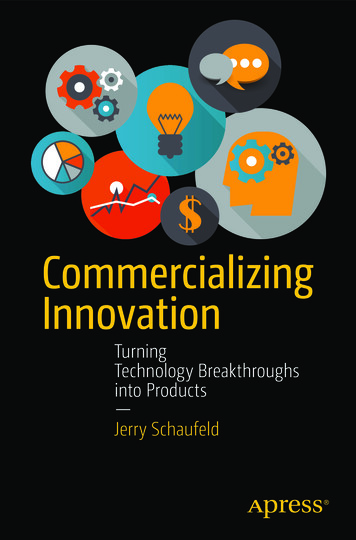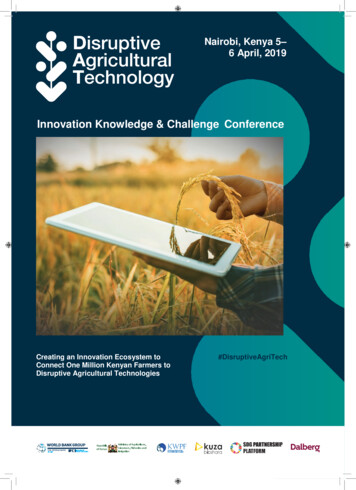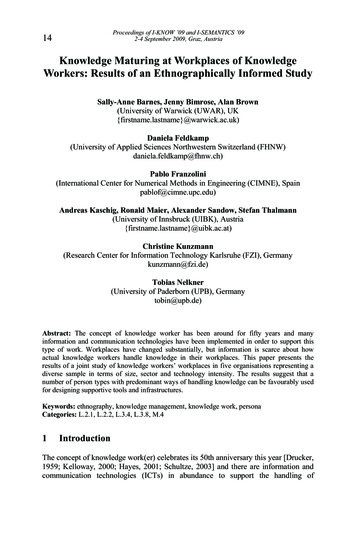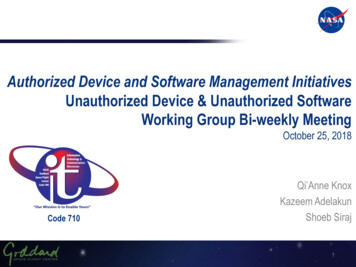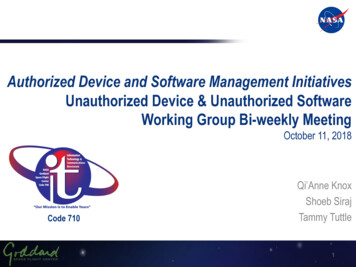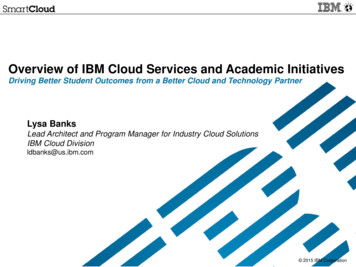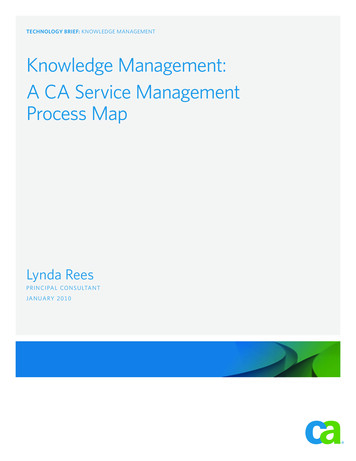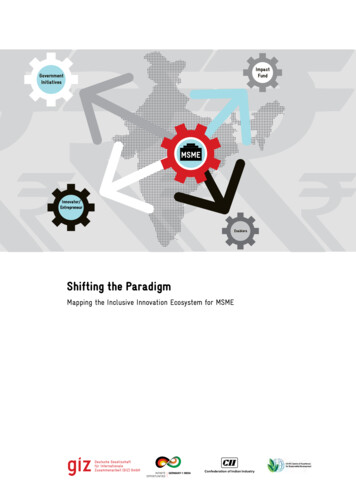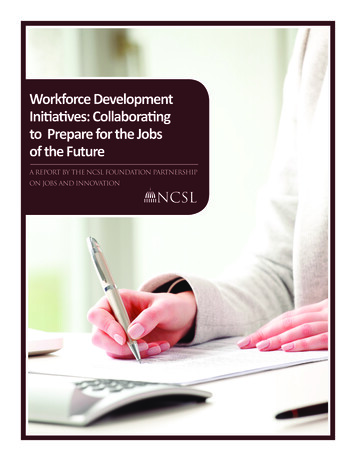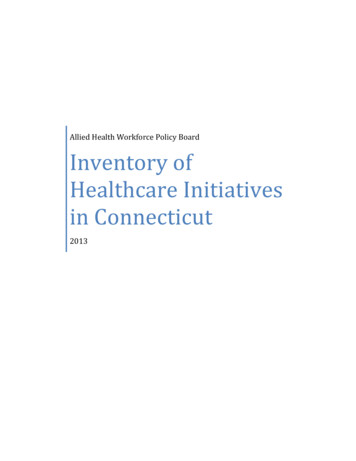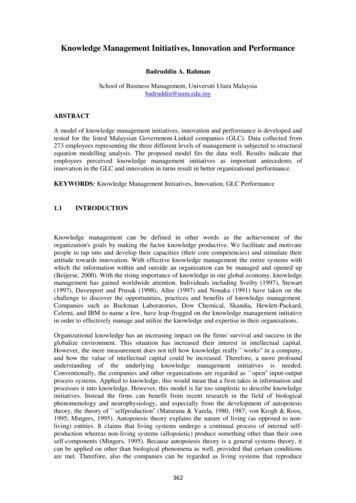
Transcription
Knowledge Management Initiatives, Innovation and PerformanceBadruddin A. RahmanSchool of Business Management, Universiti Utara Malaysiabadruddin@uum.edu.myABSTRACTA model of knowledge management initiatives, innovation and performance is developed andtested for the listed Malaysian Government-Linked companies (GLC). Data collected from273 employees representing the three different levels of management is subjected to structuralequation modelling analysis. The proposed model fits the data well. Results indicate thatemployees perceived knowledge management initiatives as important antecedents ofinnovation in the GLC and innovation in turns result in better organizational performance.KEYWORDS: Knowledge Management Initiatives, Innovation, GLC Performance1.1INTRODUCTIONKnowledge management can be defined in other words as the achievement of theorganization's goals by making the factor knowledge productive. We facilitate and motivatepeople to tap into and develop their capacities (their core competencies) and stimulate theirattitude towards innovation. With effective knowledge management the entire systems withwhich the information within and outside an organization can be managed and opened up(Beijerse, 2000). With the rising importance of knowledge in our global economy, knowledgemanagement has gained worldwide attention. Individuals including Sveiby (1997), Stewart(1997), Davenport and Prusak (1998), Allee (1997) and Nonaka (1991) have taken on thechallenge to discover the opportunities, practices and benefits of knowledge management.Companies such as Buckman Laboratories, Dow Chemical, Skandia, Hewlett-Packard,Celemi, and IBM to name a few, have leap-frogged on the knowledge management initiativein order to effectively manage and utilize the knowledge and expertise in their organizations.Organizational knowledge has an increasing impact on the firms' survival and success in theglobalize environment. This situation has increased their interest in intellectual capital.However, the mere measurement does not tell how knowledge really works'' in a company,and how the value of intellectual capital could be increased. Therefore, a more profoundunderstanding of the underlying knowledge management initiatives is needed.Conventionally, the companies and other organizations are regarded as open'' input-outputprocess systems. Applied to knowledge, this would mean that a firm takes in information andprocesses it into knowledge. However, this model is far too simplistic to describe knowledgeinitiatives. Instead the firms can benefit from recent research in the field of biologicalphenomenology and neurophysiology, and especially from the development of autopoiesistheory, the theory of selfproduction'' (Maturana & Varela, 1980, 1987; von Krogh & Roos,1995; Mingers, 1995). Autopoiesis theory explains the nature of living (as opposed to nonliving) entities. It claims that living systems undergo a continual process of internal selfproduction whereas non-living systems (allopoietic) produce something other than their ownself-components (Mingers, 1995). Because autopoiesis theory is a general systems theory, itcan be applied on other than biological phenomena as well, provided that certain conditionsare met. Therefore, also the companies can be regarded as living systems that reproduce362
themselves and their own strategic components and boundary elements and in a continuousmanner (Maula, 2000).The three knowledge management initiatives are: creation, dissemination and application.Once organizational objectives are set (the usual case is setting the performance indicators toinclude both financial and non-financial) and existing knowledge is assessed, a relevantknowledge strategy (such as innovation) can be crafted which will give a helpful start to allthe knowledge workers. Knowledge management can be applied to individuals, groups, ororganizational structures. It has a strategic and normative aspects as well as the operationaluse. Identifying external knowledge means analysing and describing the company’sknowledge environment. A surprisingly large number of companies now find it difficult tomaintain a general picture of internal and external data, information and skills. This lack oftransparency leads to inefficiency, uninformed decisions and duplication. Effectiveknowledge management must therefore ensure sufficient internal and external transparency,and help individual employees to locate what they need. Companies import a substantial partof their knowledge from outside sources. Relationships with customers, suppliers, competitorsand partners in co-operative ventures have considerable potential to provide knowledge – apotential that seldom fully utilized. Firms can also buy knowledge which they could notdevelop for themselves by recruiting experts or acquiring other particularly innovativecompanies. Systematic knowledge management must take these possibilities into account.Knowledge development is a building block that complements knowledge acquisition. Itsfocus is on generating new skills, new products, better ideas and more efficient processes.Knowledge development includes all management efforts consciously aimed at producingcapabilities which are not yet present within the organization, or which do not yet exist eitherinside or outside it. Traditionally, knowledge development is anchored in the company’smarket research and in its research and development department; however, importantknowledge can also spring from any other part of the organization. In this building block, weexamine the company’s general ways of dealing with new ideas and utilizing the creativity ofits employees. When considered from the point of view of knowledge management, evenactivities that were previously regarded simply as production processes can be analysed andoptimised so as to yield knowledge. While knowledge management offers cost savings, thereal value is in more forward-looking knowledge workers that drive technological innovationprocess to make innovation possible, bringing together the technical and commercial worldsin profitable ways (Darroch, 2005).2.1LITERATURE REVIEWPenrose (1959) says, the knowledge of an employee is based upon his or her skills andexperiences and ability to absorb new knowledge. Therefore, while knowledge is a resourcein its own right, the manner in which we manage knowledge will influence the quality ofservices that can be leveraged from each resource own by the firm. Nelson and Winter (1982)add that knowledge management can be viewed as a coordinating mechanism to be transformresources into capabilities. Knowledge management is one of many components of goodmanagement. Sound planning, savvy marketing, high-quality products and services, attentionto customers, efficient structuring of work and thoughtful management of an organization’sresources are all critical to compete in today’s marketplace. Knowledge management mayhelp create the competitive edge in today’s global environment. Possible consequences ofeffective knowledge management include: competitive advantage (Connor & Prahalad, 1996;Hall, 1993) and innovation (Antonelli, 1999; Carneiro, 2000; Dove, 1999; Nonaka &Takeuchi, 1995).363
Sveiby asserts that business managers need to realize that unlike information, knowledge isembedded in people, and knowledge creation occurs in the process of social interaction(Sveiby, 1997). A lot of intellectual capital resides in the minds of knowledge workers.Companies such as Andersen Consulting, Ford, and Monsanto encourage employees to put“tacit” knowledge, the know-how in their heads, into “explicit” form, such as written reportsor video presentations. This captured knowledge is then stored in repositories such asdatabases and intranet Web servers, all of which users can search. An organization'scompetitive potential rests almost wholly on how well it manages and deploys its corporateassets. These assets are comprised of financial, and tangible and intangible elements. Forsimplicity, consider financial assets such as cash, and tangible assets including plant,equipment, and inventory; intangible assets including core competencies and technologies,management skills, culture, brand image, consumer loyalty, patents, distribution channels,and the like. In addition to being aware of the knowledge process and the infrastructureswithin which it takes place, a knowledge mapping project should have a conceptual focus(Soliman, 1998). Ideally the focus will be the fundamental business issues of the organizationsuch as reducing errors or rework, or minimizing cycle time in some manufacturingorganizations. Then the mapping project will provide useful results that improve theorganizational efficiencies. Zack (1999) has advocated using the well known SWOTtechnique (strengths, weaknesses, opportunities and threats) as a tool to develop a knowledgemapping strategy specifically tailored to an organization's needs. Zack advises thatknowledge-based SWOT analysis could lead to mapping knowledge resources andcapabilities against strategies.Traditionally corporate assets have been narrowly defined to include essentially only financialcapital and tangible assets. However, it is clear that organizations require a much broaderrange of resources to be successful in any current market, and must ensure the right mix oftangible and intangible resources to provide desirable business outcomes. This is to say thatorganizations must not only value intangible assets for their inherent contribution to businesssuccess, but must actively and carefully consider their state in relation to financial andtangible assets during business strategizing and plan implementation. Empirical study byDarroch (2005) reveals that each component of knowledge management initiatives willpositively affect innovation. For innovation to take effect, knowledge workers must first havethe knowledge about the key internal and external environments of that strategically affectingthe firm – the more knowledge, and the greater the variety of knowledge, the better. Second,knowledge must flow freely around the firm – the better the dissemination of knowledge thegreater the possibility of innovation as more people within levels and departments of theorganization are exposed to new knowledge that interacts with knowledge already held.Lastly, the more response and agile an organization towards applying new knowledge themore likely will it be innovative. Thus, the relevant hypotheses are:H1:GLC with knowledge management initiatives tends to be more innovative.H1a:Knowledge creation will lead to innovation.H1b:Knowledge dissemination will lead to innovation.H1c:Knowledge application will lead to innovation.Organizational knowledge is known to be important intangible resources of an organization toenable sustainable competitive advantage (Hitt, Ireland & Hoskisson, 1999). By managingknowledge firms will be able to accurately predict the nature and commercial potential of364
changes in the environment and the appropriateness of strategic and tactical actions (Cohen &Levinthal, 1990). Without knowledge management, organizations are less capable ofdiscovering and exploiting new opportunities whilst evading new threats. For example,knowledge about markets and technology has strong potential for the firms to improve theirperformance because this will increase their abilities to discover and exploit marketopportunities. This can be done through: (1) awareness of customer problems may have greatgenerality and thus constitute real market opportunities; (2) it is easier to determine themarket value of new scientific discoveries, technological changes etc.; (3) the locus ofinnovation often lies with users of new technologies who cannot easily articulate their needsfor the not-yet-developed solutions to problems, and therefore organization must share someof the tacit knowledge as it’s users (Cohen & Levinthal, 1990; Shane, 2000; von Hippel,1994). Meanwhile, technological knowledge can also enhance a firm’s ability to effectivelyexploit an opportunity by, for example, determining the product’s optimal design to optimizefunctionality, cost, and reliability and ultimately the economic impact of exploiting theopportunity (Rosenberg, 1994). Therefore, technological knowledge enables firm to rapidlyexploit opportunities or to be able to respond quickly when competitors make advancements(Cohen & Levinthal, 1990). Capon, Farley, Lehmann and Hubert (1992) profiled innovativefirms in the USA and conclude that by acquiring other firms as a means of accessing newknowledge, did not significantly affect the ability of a firm to innovate. Instead by hiringscientists, spending money on applied R&D to develop new products and encouragingscientific discussion enhances the ability of a firm to innovate. Griffin and Hauser (1996)examined the integration between R&D and marketing, citing such integration as animportant antecedent of new product success. In fact a positive relationship betweeninnovation and performance is fairly well established in the extant literature (Avlonitis &Gounaris, 1999; Atuahene-Gima, 1996; Capon et al., 1992; Deshpande et al., 1998; Manu &Siram, 1996; Mavondo, 1999; Vazquez et al., 2001). On this basis the following hypothesesare presented:H2:Innovative GLC will perform better.H3: There is a positive correlation between “knowledge management initiatives”and “performance” when intervened by “innovation”.3.1METHODOLOGYThis was a cross-sectional studies carried out in a natural environment where work proceedednormally or in other words in non-contrived settings. Since this study was a correlation study,it was conducted in the natural environment of the organizations, in which the researchers’interference was very minimal with the normal work flow of work in these organizations. Therespondents selected were employees of the listed Malaysian Government-Linked Companies(GLC). We used a cluster sampling design
equation modelling analysis. The proposed model fits the data well. Results indicate that employees perceived knowledge management initiatives as important antecedents of innovation in the GLC and innovation in turns result in better organizational performance. KEYWORDS: Knowledge Management Initiatives, Innovation, GLC Performance 1.1 INTRODUCTION Knowledge management can be
